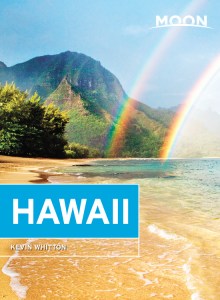Central Maui Water Sports (Including the Best Surf Breaks)
From surfing to paddleboarding, kitesurfing to windsurfing, Central Maui has no shortage of prime locales. Here’s a roundup of the best of each, including directions, seasonal weather information, schools and outfitters, and the level of skill you’ll need to tackle each spot.
Surfing
Since the beaches of Central Maui face north and east, the majority of the surfing on this side of the island takes place October-April. Some eastward-facing locations can pick up windswell during summer, but often it’s choppy, and sloppy. No surf schools operate along this stretch of coast; anyone opting to surf around here needs to be at least an intermediate. Since part of this stretch runs along Maui’s fabled North Shore, only the spots that are accessible to the average surfer are mentioned.
Kahului Surf Spots
The most popular surf break in Kahului is Lowers at Kanaha Beach Park. If you’re an intermediate to advanced longboarder, then this is the place to come on any sort of northerly swell. To reach the surfing section of the park, travel down Amala Place all the way to the end of the road and park in one of the last two parking lots. Grab your board and wear your slippers as you walk down to the shoreline to avoid kiawe thorns and burrs. Once you’re standing on the sand, look for the lifeguard tower you’ll paddle out from. The wave at Kanaha breaks on an offshore reef. Given the length of the paddle (usually about 15 minutes), Kanaha is frequented by longboarders and stand-up paddle surfers. When standing in front of the lifeguard tower, you’ll notice a defined channel for reaching the lineup, and the surf usually won’t close it out until the faces reach 10 feet or higher. Mornings are best before the wind picks up (usually around 11am).
Wailuku Surf Spots
Looking for a mellow longboarding wave? There’s a break in front of Waiehu Beach Park that usually has fewer people than neighboring Paukukalo. The wave quality isn’t as good, but this is still a good wave in the early morning during any sort of north swell. As at the other breaks in the area, localism can be an issue, so share the waves. To reach Waiehu Beach Park, travel along Waiehu Beach Road before taking a right-hand turn on Lower Waiehu Beach Road, where you will follow it to the parking lot at the end.
Windsurfing
Maui is one of world’s top windsurfing destinations. The summer trade winds are consistent, arriving like clockwork around 11am to offer 5-6 hours of steady, flat water. During winter, the trade winds aren’t nearly as consistent and waves reach 15 feet or higher.
There’s strictly no windsurfing before 11am, and Kanaha is split into two main launching areas conveniently named Uppers and Lowers. Many of the windsurfing schools operate by Uppers at a cove known as Kook’s Beach. Lowers is in the area by the lifeguard tower and is the preferred launching point for most Maui visitors. In between the two areas is a roped-off swimming zone off limits to all windsurfers even if you’re swimming your board. If there are waves breaking on the reef, you’ll notice a channel off the lifeguard stand where you can get past the break and out beyond the surf.
For more information on Maui windsurfing go to www.mauiwindsurfing.net for photos, rental operators, and descriptions of the various launching sites. Or, for a live cam of the conditions at Kanaha, check out www.mauiwindcam.com.
Kitesurfing
The best place for kitesurfing on Maui is at the aptly named Kite Beach, a place of hallowed ground where the sport was born. This is the beach where all kitesurfing schools operate. Even if you aren’t a kitesurfer yourself, this is a fantastic spot to sit and watch as hundreds of colorful kites zip through the gusty trade winds. To reach Kite Beach from Hana Highway follow Hobron Avenue toward the Port of Kahului and make a right on Amala Place. Kanaha Kai rental shop will be on your right, then follow the road for a mile until just before a cement bridge. A dirt parking lot on the left side of the road will have a number of vans offering lessons and information. Since Kite Beach is so close to Kanaha, the unwritten rule is that kitesurfers are supposed to stay downwind (closer to Kahului Harbor) of the windsurfers to avoid a high-speed entanglement. Even though this is one of the premier spots on the planet for kitesurfing, the winds can be strong and gusty during the summer (particularly on an east wind), and the waves can be big during winter. Unless you’re an advanced kitesurfer, take a lesson to learn the local conditions and ensure you have the safest, most enjoyable kitesurfing experience possible.
For information relating to Maui kitesurfing, safety, and maps of which areas are prohibited, check out www.kitesurfmaui.org. For a webcam of current wind and weather conditions, go to www.kitebeachcam.com.
Stand-Up Paddleboarding
There aren’t any stand-up paddleboard lessons offered along the island’s central coast. If you have your own board (or have rented one), the best bet for flat-water paddling is Kanaha Beach Park on the inside of the reef. Since the reef is a couple of hundred yards offshore, it forms a nice lagoon on the inside, and the water is often calm during the morning before the trade winds pick up. If you’re a competent paddle surfer and want to get into the waves, paddle through the channel off the lifeguard stand at Lowers, where you will find waves perfectly suited for stand-up paddle surfing. These are only for advanced paddlers who can handle themselves in large surf.


